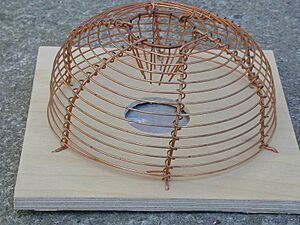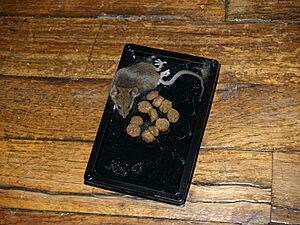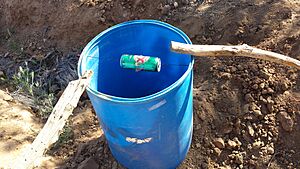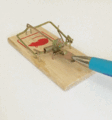Mouse trap facts for kids
A mouse trap is a clever device designed to catch mice. People use them to control mice that might be living in their homes or other buildings. Mouse traps often have a small piece of food like cheese or peanut butter to attract the mouse. If too much food is placed on the trap, a mouse might be able to eat it without getting caught. While mostly for mice, some traps can also catch other small pests.
Contents
Why Do People Use Mouse Traps?
Mice can be a nuisance in homes. They might chew on wires, damage food, or spread germs. Using mouse traps helps people keep their homes clean and safe from these small visitors. It's a way to manage pests without using harmful chemicals.
Different Types of Mouse Traps
There are many kinds of mouse traps, each working in a different way. Some traps catch mice quickly, while others aim to capture them alive so they can be released elsewhere.
Snap Traps
How Snap Traps Work
Snap traps are one of the oldest and most common types. They usually have a spring-loaded bar. When a mouse touches the bait, the bar snaps down very quickly. These traps are often made of wood or plastic. They are designed to catch the mouse instantly.
Using Snap Traps Safely
It is important to handle snap traps carefully. The spring can be strong. Adults should set these traps. Always place them where children or pets cannot reach them.
Live-Capture Traps
Catching Mice Alive
Live-capture traps are designed to catch mice without hurting them. These traps are like small cages or boxes. A mouse goes inside to get the bait, and then a door closes behind it. The mouse is trapped but not injured.
Releasing Captured Mice
Once a mouse is caught in a live trap, you can take it far away from your home. Then, you can open the trap and let the mouse go free. This is a good option if you do not want to harm the mice.
Electronic Traps
Modern Mouse Control
Electronic mouse traps use electricity to catch mice. When a mouse enters the trap, it steps on special plates. This completes an electrical circuit, which quickly and humanely stops the mouse. These traps are often powered by batteries.
Benefits of Electronic Traps
Electronic traps are often considered very clean. They are easy to empty and reuse. They also do not use any chemicals.
Glue Traps
Sticky Surfaces
Glue traps are flat pieces of cardboard or plastic covered with a very sticky adhesive. When a mouse walks onto the trap, it gets stuck to the glue. These traps are simple to use.
Considerations for Glue Traps
Some people prefer not to use glue traps. This is because the mouse remains stuck and can be distressed. It's important to check these traps often if you use them.
Bucket Traps
DIY Mouse Traps
Bucket traps are often homemade. They usually involve a bucket of water and a ramp or spinning roller above the water. Mice try to reach bait on the roller or at the top of the ramp. They then fall into the bucket.
Different Designs
There are many designs for bucket traps. Some use a spinning soda can or bottle. Others use a simple ramp leading to a tipping platform. These traps can catch multiple mice.
History of Mouse Traps
People have been trying to catch mice for a very long time. Early traps were often simple snares or pits. The first patented snap trap was invented in the late 1800s. James Henry Atkinson invented a "Little Nipper" trap in 1897. William Hooker also designed a spring-loaded bar mousetrap in the 19th century. Over time, new designs have continued to appear, making traps more effective and sometimes more humane.
Images for kids
See also
 In Spanish: Ratonera para niños
In Spanish: Ratonera para niños













